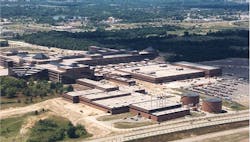Consider Chilled Water Thermal Energy Storage
Large, chilled water (CHW) thermal energy storage (TES) systems have seen extensive use for over 40 years to manage peak electric demand from air-conditioning loads in industrial applications, and especially in operations where cooling loads fluctuate widely over short time periods (e.g., batch processes, R&D facilities).
CHW TES involves a large insulated water tank, generally installed above-grade using welded-steel construction. The tank remains filled with water at all times. The lower region contains relatively dense, cool, chilled water supply (CHWS), while the upper region contains less dense, warmer, chilled water return (CHWR). A relatively narrow “thermocline” (a temperature gradient similar to that observed in a quiescent lake warmed by the sun) separates the two zones with no physical barrier between the regions. TES charging occurs off-peak, by pumping CHWR from the upper region to a chiller plant, while cooled CHWS flows to the lower region; it discharges on-peak, pumping CHWS from the lower region to the cooling loads, while warm CHWR flows to the upper region. Conventional CHW TES is limited to a minimum supply temperature of 39 to 40°F, the temperature at which plain water exhibits its maximum density. However, modified versions of the technology can operate at lower temperatures.
Operating savings accrue from reduced peak electric demand, and shifting electric energy use from high-cost on-peak periods to low-cost off-peak periods. Capital cost savings relative to conventional (non-TES) chiller plant capacity also occur. This is because non-TES systems require an installed chiller plant capacity to equal the instantaneous peak load on a peak design day (plus any necessary spare capacity), while TES-equipped systems merely require an installed chiller plant capacity equal to the equivalent average load (plus any necessary spare capacity). The avoided chiller plant installed cost often far exceeds the cost of the required CHW TES system installation. This net capital saving can occur in several situations:
1. New facility construction,
2. Retrofit facility expansion or other load growth, or
3. Retirement of existing aging, inefficient, or unreliable chiller plant capacity.
The following example, from the 2-million-ft2 corporate R&D complex for Chrysler Motors (now Stellantis) in Auburn Hills, Mich., illustrates both operating and capital savings. Chilled water TES was built into the facility’s central cooling system during its initial construction to serve a projected peak cooling load of 16,000 tons. A conventional (non-TES) chiller plant requires 17,700 tons of capacity (including spare capacity). However, with 68,000 ton-hrs of CHW TES included, the chiller plant capacity was reduced to 11,400 tons. The 6,300-ton chiller plant capacity reduction, offset by two 3.1-million-gal TES tanks, produced a net capital cost reduction of $3.6 million. There was also a $1 million annual energy cost saving due to reductions of 7,600 tons of on-peak cooling, and 5.7 MW of electric demand. The two above-grade, welded-steel TES tanks also provide emergency fire protection.
Facilities that employ combined heat and power (CHP) systems with a combustion turbine (CT) for on-site power generation also can use chilled water TES. TES flattens the daily cooling and electric load profiles, which allows for a larger CT (with a lower unit capital cost in $/kW) operating fully loaded for more hours per year, thus improving CHP economics. Also, CTs lose power during hot weather, just when the power demand and value are highest. TES can be coupled with a turbine inlet cooling (TIC) system to maximize power output at those times, while also minimizing the total unit capital cost in $/kW.
Hundreds of CHW TES applications exist, totaling well over 10-million ton-hours of stored cooling and 2-million tons of peak load shift, equivalent to well over 7,000 MWh of stored electricity and 1,500 MW of peak load shift. Oil and petrochemical industry users include ARCO, Exxon/Mobil, Halliburton, Saudi Aramco, Shell and Texaco; in the pharmaceutical industry they include Abbott Laboratories, Boehringer-Ingelheim and Wyeth-Ayerst.
If you own or operate a facility with a large, time-variable chilled water load, or with a CHP gas turbine, you should consider CHW TES!
Editor’s note: This article was written by a colleague of our regular columnist, Alan Rossiter.
John Andrepont is the founder and president of The Cool Solutions Company, providing professional services to support technical and commercial development of thermal energy storage (TES), district cooling (DC), and turbine inlet cooling (TIC) applications. He graduated from Rensselaer Polytechnic Institute (RPI) in Troy, New York, with Bachelor’s and Master’s degrees in mechanical engineering. He is the author of numerous technical papers and articles and is the inventor of over a dozen U.S. patents. Email him at [email protected].
